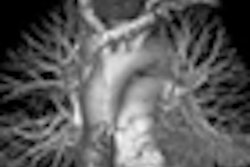
VIENNA - Patients gain important benefits when they are allowed to initiate their own breath-holds for MRI exams, and the exam quality doesn't suffer, according to research presented on Saturday at ECR 2016.
Results of two studies, one examining patient breath-hold preferences and one looking at image quality in patients undergoing MRI of the liver, showed that self-initiated breath-holds had more advantages than drawbacks, concluded the group from Örebro University in Sweden.
 Eva Funk from Örebro University.
Eva Funk from Örebro University."The main aim of these two studies was to investigate two different breath-hold techniques: the conventional way ... and the second technique was when the patient initiated the breath-hold by giving a signal to the radiographer when the patient was ready to hold the breath," said Eva Funk in her talk. "We also examined the patient experience of the examination and the image quality."
All patients had been referred for MRI of the liver; there were 28 patients in the breath-hold preference study and 29 patients in the image quality study (7 men, 21/22 women), with a mean age of 52 years, she said.
Study 1
In the first study, one of the MRI sequences was conducted twice -- once with a patient-initiated breath-hold and once with a radiographer-instructed breath-hold -- with the sequence order randomized, Funk said. Nearly half of the 28 patients preferred the self-initiated breath-hold, with far fewer patients preferring the radiographer-instructed breath-hold.
| Patient preference for breath-holds | |
| Preferred technique | Patients |
| Self-initiated | 46.5% |
| Instructed | 21.5% |
| No preference | 32% |
| Total | 100% |
"The patients told about their experience with the self-instructed technique, and the advantage was that they regained some control," Funk said. "The disadvantage for patients who preferred the instructed technique was that the self-instructed technique imposed a responsibility they did not want to have."
For those who preferred the instructed technique, it imposed a welcome measure of structure, according to Funk, but this group also reported difficulties in regulating their own breath. Some instructed patients experienced heightened anxiety due to a perceived loss of control, she added.
Study 2
The second study examined the quality of MR images from both the self-instructed and instructed breath-holds. Radiologists reviewed the images in a blinded fashion and compared them visually. They found no significant differences in image quality between the two breath-hold methods.
"We could not see anything different in artifacts or image quality," Funk said.
"The results show that self-initiated breath-hold can be seen as a new alternative" that is worth looking at in MRI practice. This alternative is promising for patients as it gives them a new measure of control, she concluded.


















